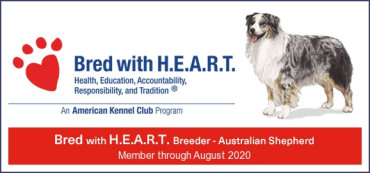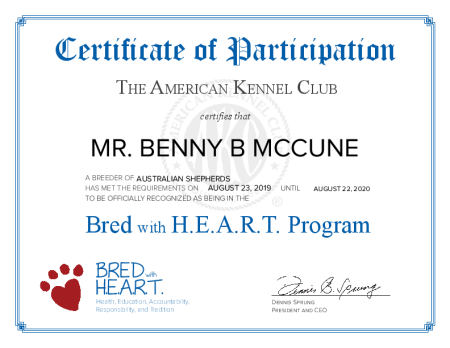

HONEYCREEKAUSSIES.COM
Australian Shepherds - The Breed that Works.
Honeycreek Australian Shepherds
We Love Our Friends
Aussie's - Loyal, Playful, Loving
The Family Welcomes You To Our World

History of the Australian Shepherd
Are they from Australia?
The Aussie as we know them.
History
The Australian Shepherd's history is vague, as is the reason for its misleading name. It is believed by some that the breed has Basque origins in Spain and was used there by shepherds. Those shepherds might, then, have emigrated to the West Coast of the United States via Australia. However, scientific evidence has shown that the breed has lineage from American dogs that originally came over the Bering Land Bridge. What is known is that it developed in western North America in the 19th and early 20th centuries.
An Australian shepherd from working lines; early breeders chose dogs for their abilities rather than conformation.
The Australian Shepherd was a particularly tireless sheep herder in the Rocky Mountains because it is relatively unaffected by altitude. Ranchers in Boulder, Colorado, began breeding the dogs, which would attract purchasers from as far west as California for their legendary sheep herding abilities.
Breeds as we know them today did not exist before Victorian times, but local variations of the ancestors of current breeds came into America along with their owners and livestock. Included are some that are now extinct or that have merged into other breeds. These may have included some British herding dogs, native dogs from North America (originating in Asia/Siberia) as well as dogs from Germany, Spain including the Carea LeonÚs. For many centuries, shepherds were more interested in dogs' working abilities than their appearance. As a result, over time, shepherds interbred dogs that they believed would produce better workers for the given climate and landscape. In the eastern U.S., terrain and weather conditions were similar to that of Europe, however, so the existing imported breeds and their offspring worked well there.
In the American West, conditions were quite different. Spanish flocks were introduced for food and fiber which was mainly the Churra. The Spanish dogs that accompanied them to American West proved well suited for their job in the wild and dangerous territory. They were highly valued for their ability to herd and protect their charges from predators on the open range. In the arid and semiarid areas inhabited by early Spanish settlers, temperatures reached extremes of hot and cold, and fields varied in altitude from sea level to the higher, rougher Sierra Nevada and similar mountain ranges. The ranchers in these areas often pastured livestock on remote ranges. They preferred more aggressive herding dogs that served in the capacity of herder and guardian.
With the 1849 California Gold Rush, a massive migration occurred to the west coast. The Gold Rush and the Civil War brought great demand for mutton and wool. Along with easterners came flocks of sheep and their eastern herding dogs; from the southwest came people and sheep. But it was just as effective to bring sheep in by ship, and in they came, including flocks from Australia and other regions, along with shepherds and their own herding breeds.
It is not clear where the name "Australian" came from, although a theory suggests that they were named for those imported sheep that they herded. It is also possible that many of the dogs coming from Australia were blue merle and the adjective "Australian" became associated with any dogs of that coat color. The Australian Shepherd was initially called by many names, including Spanish Shepherd, Pastor Dog, Bob-Tail, New Mexican Shepherd, California Shepherd, and Austrian Shepherd.
Recent history
Development of the breed began in the American west. The breed's foundation bloodlines are depicted in the Australian Shepherd Genealogy Chart showing the relationship between the early families of dogs. The American Kennel Club ranked the Australian Shepherd as the 20th most popular breed in the United States in 2013.
Selective breeding for many generations focused on aspects of the dog that enabled it to function as an effective stock dog in the American west. It had to handle severe weather; have plenty of speed, athleticism, energy, and endurance; and be intelligent, flexible, and independent, while remaining obedient. The actual foundation for the Australian shepherd was established between the 1940s and the early 1970s, when the Australian Shepherd Club of America was formed and the registry was started. They became popular as performing dogs in rodeos.
Their stunts and skills earned them places in several Disney films, including Run Appaloosa Run and Stub: The Greatest Cow dog in the West. An Australian shepherd was featured in the film Flight of the Navigator (1986) and the TV series Flash Forward (1996). More recently, an Australian shepherd starred in the film Famous Five (2012) and its sequels.
All credits for the content of this page go to: Wikipedia, the free encyclopedia


